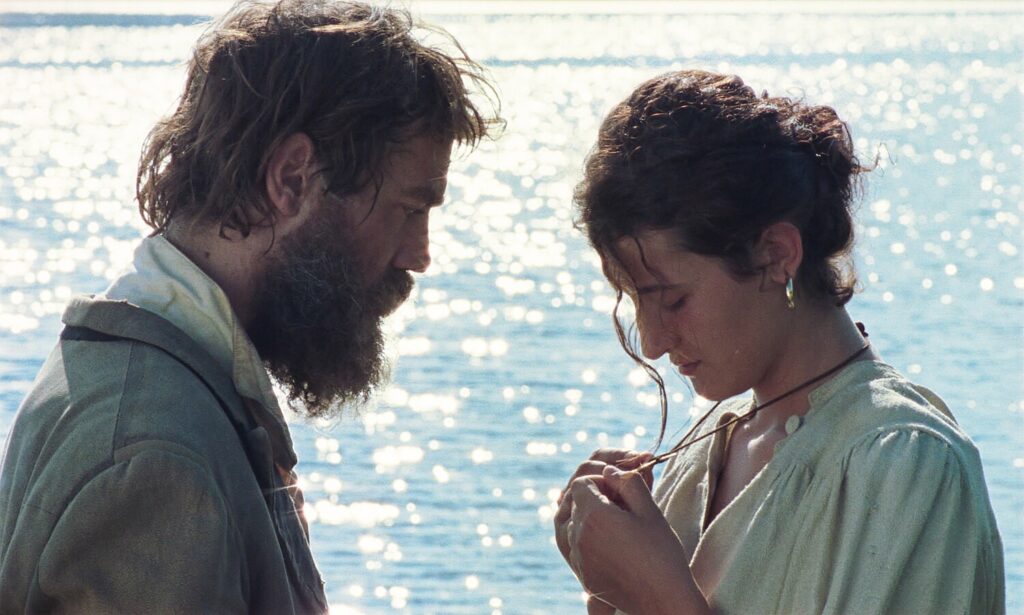Peasant legend meets cinematic folklore in “The Tale of King Crab,” the first fictional feature from a pair of young Italian filmmakers — Alessio Rigo de Righi and Matteo Zoppis — whose reverence for the rich, haunting rattle and moan of old stories about strange fates is palpable in nearly every shot of this artisanal adventure.
The pair’s previous films (“Il Solengo” and “Belva Nera”) were documentaries inspired by folk tales passed down and around by crusty Italian hunters in a mountainous region north of Rome. Here, they’ve drawn from that well again, and even used a framing device of these real-life close-knit men gathered around a table, spinning a yarn about a long-ago doctor’s son in their ancient village of Vejano who started a fight with an aristocrat that didn’t exactly go his way.
The man is Luciano, played with Herzogian intensity by first-time actor Gabriele Silli (an artist friend of the directors). Wandering the town like an angry misfit practicing for his time as a town ghost, he’s an outcast to the townsfolk: always drunk, rumored to be nuts and dangerously in love with his childhood chum Emma (Maria Alexandra Lungu). She can see the good, gentle soul behind his madman’s thicket of a beard and large, penetrating eyes, and her teasing, tender attention — rendered with delicacy and humor in exquisitely shot scenes taking full advantage of this rural area’s hushed beauty — is a calming influence on him. But the prospect of their coupling puts Luciano in the crosshairs of her protective goatherd father, Severino (Severino Sperandio).
It’s Luciano’s embittered, violent reaction to the regional prince’s sealing off of a castle passageway long used by citizens that seals his destiny, however, the consequences of which send him into an exile that brings the first half of “The Tale of King Crab” to a fiery close, with nary a glimpse of a crustacean to be had.
That’s saved for Chapter 2, a separate yet connected narrative set in forbidding, beautiful Tierra del Fuego during its 19th century gold rush, playing out like a John Huston adventure by way of a spaghetti western. Silli is back as a Salesian priest whose method for finding a rumored Spanish treasure in a mountain lake is a red king crab kept in a bucket. On his tail are fortune hunters with rifles. Once more, obsession and solitude can shift a man’s destiny — not unlike a crab’s movements — sideways.
Sometimes, in its more brooding moments, “The Tale of King Crab” can feel a little too careful and worshipful about its venturing into the meat and might of lore. Especially in the second half, Lucretia Martel’s galvanizing, evocative engagement with history’s intimate spaces comes to mind, and the comparison can sometimes be a tad wanting. But for the most part, the filmmakers are after their own period-thick blend: how respect for oral tradition and love for a ripping yarn can be a gateway to invention and allusion.
At the very least, they’re wonderfully confident artists with image, texture and music. The Italian countryside, as explored in Simone D’Arcangelo’s cinematography and the directors’ shotmaking, is captured in all its heavy beauty, and the lined, sunbaked faces of the area’s denizens provide their own painterly topography. When the movie flings itself halfway across the world for the second half, the change of scenery to the gray-green vastness of southern Argentina’s chilly archipelago is bracing, as is the almost mystical redness of that crab. Meanwhile, Vittorio Giampietro’s score — a spare meld of folk singing, percussion and lonely instruments — is its own artful coloring.
There are times when “The Tale of King Crab” seems like it could have been made in the silent era, so dedicated are Rigo de Righi and Zoppis to the simple, dramatic power of what they choose to show us. Their characters search for love, justice and gold while the filmmakers make clear what they treasure: ageless tales like these.
‘The Tale of King Crab’
In Italian and Spanish with English subtitles
Not rated
Running time: 1 hour, 46 minutes
Playing: Starts April 29, Landmark Nuart, West Los Angeles

